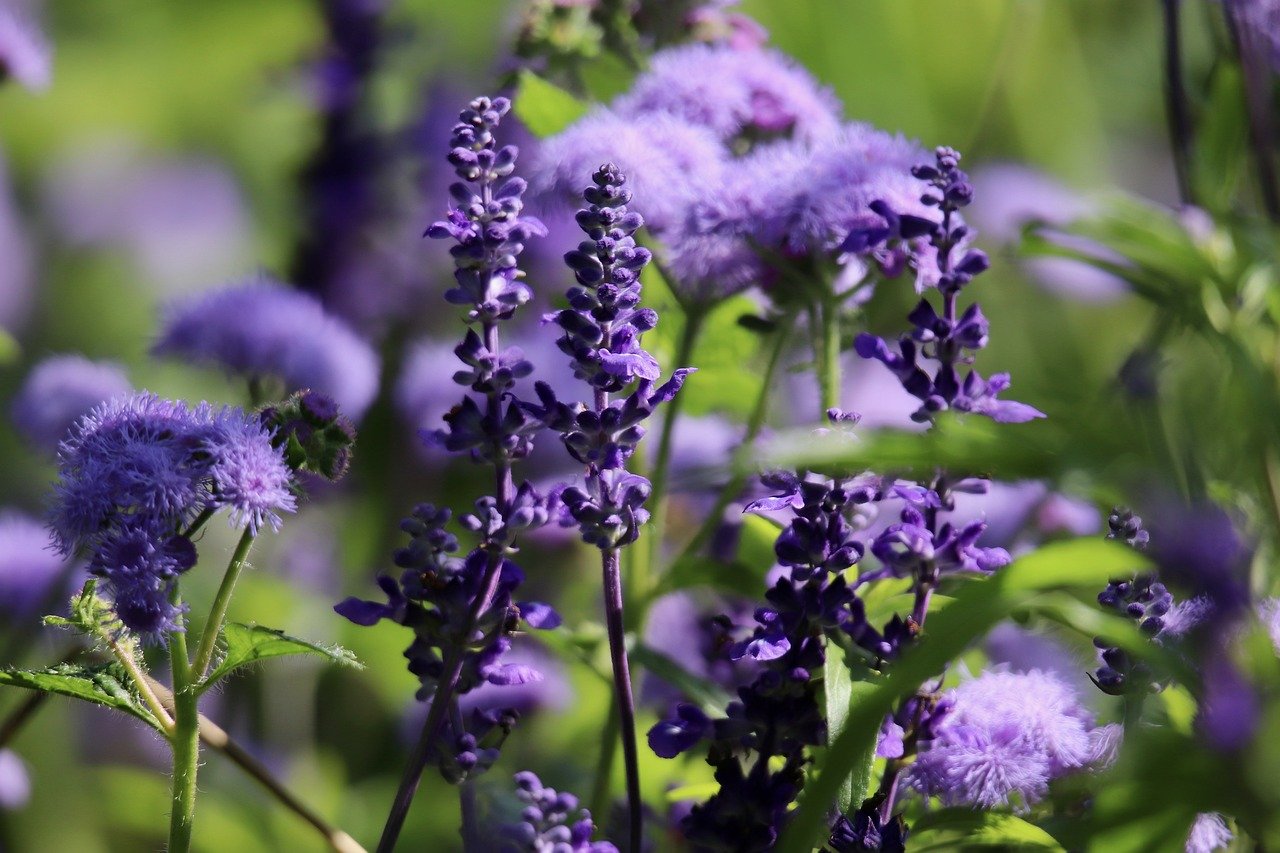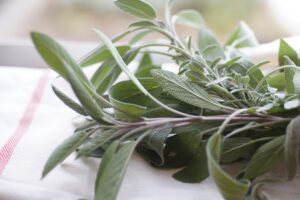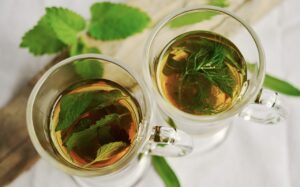Sage
Overview
Sage, a member of the mint family, is a versatile perennial herb recognized for its aromatic leaves. With a hearty nature and preference for sunny spots, it flourishes in many gardens. Culinary sage is prized for its earthy flavor in cooking, while the plant’s ornamental qualities add charm to any landscape. Simple to cultivate, and thriving even indoors, sage’s robust leaves can be harvested throughout its growing season to enhance a variety of dishes.

Characteristics
Known for its aromatic leaves, culinary uses, and medicinal properties, as well as its ability to thrive in sunny environments.
Region
The sage plant is typically grown in regions with temperate climates but can adapt to various environments.
Natural Habitat
Commonly found in Mediterranean regions on dry slopes and in scrubland.
Cultivation
Requires full sunlight (at least 6 hours daily), moderate watering, and thrives in well-draining soil.
Uses and Benefits
Sage, or Salvia officinalis, brings a symphony of earthy and slightly peppery notes to the kitchen, making it a favorite in many culinary circles3. Whether you prefer its leaves fresh or dried, adding sage to your dishes can elevate the flavors in everything from meats to savory bread.
But the usefulness of sage extends beyond taste; it’s also a treat for the eyes. With its silvery-green foliage and seasonal flowers that bloom in hues of purple, blue, white, and pink, sage doubles as an ornamental delight4.
While not all sage variants are edible, those that are endow gardens and plates with a herbaceous zest and a visual feast4. To keep your sage plant thriving, remember these harvesting tips:
- Focus on harvesting the leaves rather than the stems
- Regular leaf harvesting encourages fuller growth
- Avoid over-harvesting to maintain a lush and healthy plant2
Sage’s versatility makes it a valuable addition to any home garden. Its culinary uses are vast:
- Seasoning: Sage adds depth to poultry, pork, and beef dishes
- Herbs blends: It’s a key ingredient in many herb mixes, like Herbes de Provence
- Beverages: Sage can be used to make herbal teas and cocktails
Beyond its culinary applications, sage has been used for centuries in traditional medicine for its potential health benefits, although more research is needed to confirm its efficacy1.

Cultivation Tips
Sage, being a sun-loving herb, thrives best when positioned in a spot that receives a minimum of six hours of direct sunlight each day. This exposure to ample sunlight is crucial for the development of its optimal flavor2. The versatility of sage makes it an ideal choice for various growing environments, adapting well to containers, garden beds, or even indoor settings. This flexibility allows you to select the most suitable location based on your available space and preferences5.
To ensure a plentiful sage harvest throughout the growing season, it is recommended to:
- Gently pick individual leaves as needed
- Avoid removing entire stems
- Encourage robust growth by harvesting leaves regularly2
By adopting this harvesting approach, you not only promote the healthy growth of your sage plants but also guarantee a steady supply of aromatic leaves to enhance your culinary creations. Sage’s inherent hardiness makes it an excellent choice for gardeners of all skill levels, including beginners4. So, don’t hesitate to embrace the rewarding experience of growing this versatile herb, as it is sure to enrich both your garden and your kitchen with its delightful presence.
Seasonal Considerations
Sage (Salvia officinalis), a sun-loving herb, thrives when it receives a minimum of six hours of direct sunlight each day, which helps to develop its best flavor2. This adaptable plant can be grown in various settings, such as:
- Containers
- Garden beds
- Inside your home
This flexibility allows you to choose the setting that works best for your space and lifestyle5.
To ensure a bountiful sage harvest throughout the growing season, consider the following approach:
- Gently pick individual leaves instead of removing entire stems
- This method encourages more robust growth and promotes a healthier plant
- By harvesting strategically, you’ll ensure your sage not only grows well but also enrichens your cuisine with its aromatic leaves2
Remember, sage’s hardiness is one of its greatest virtues! Even if you’re a beginner, don’t hesitate to give this versatile plant a try in your garden or home4. With proper sunlight and mindful harvesting, you’ll be enjoying the flavors and aromas of fresh sage in no time.

Issues and Troubleshooting
Sage, a beloved herb in kitchens and gardens, sometimes faces a few hiccups. Without at least six hours of sunlight each day, your sage may become leggy, stretching awkwardly for light, and this can result in diminished flavor—a real letdown for those savory dishes that rely on its robust taste2.
If you notice your sage losing its vigor, it’s a good cue to ensure it’s getting enough sun. Here are some tips to troubleshoot and maintain a healthy, flavorful sage plant:
- Provide ample sunlight: Make sure your sage receives at least six hours of direct sunlight daily. If planted indoors, place it near a sunny window or consider using grow lights.
- Avoid overwatering: Sage prefers drier conditions, aligning with its Mediterranean roots. Let the soil dry out between waterings to prevent root rot and maintain the plant’s health.
- Ensure proper drainage: Plant sage in well-draining soil and use pots with drainage holes to prevent water from accumulating around the roots.
- Prune regularly: Trim back leggy or overgrown stems to encourage bushier growth and maintain the plant’s shape. This also helps improve air circulation, reducing the risk of fungal issues.
By addressing these common issues and providing the right growing conditions, your sage should stand tall, proud, and flavorful, ready to accentuate your culinary creations and beautify your space1 2 3.
History and Folklore
Sage (Salvia officinalis) is a herb steeped in a rich tapestry of history and folklore. As a member of the mint family, sage has been revered for centuries not only for its culinary uses but also for its purported healing properties and mystical significance. In ancient times, sage was so highly prized that it was often traded for valuable goods and used in sacred rituals.
The Romans held sage in such high regard that they considered it a salvation plant, giving it the Latin name ‘Salvia’, derived from ‘salvare’, meaning ‘to save’ or ‘to heal’1. This association with healing and longevity continued into the Middle Ages, where monks cultivated sage in their monastery gardens, believing it could extend life, impart wisdom, and improve memory. The phrase “wise as a sage” is a testament to this enduring symbolism.
Throughout history, sage has been attributed with mystical properties. It was believed to have the power to ward off evil, and people would plant it near their homes for protection. This tradition of using sage for spiritual cleansing and purification persists to this day, with many cultures using it in smudging ceremonies to dispel negative energy.
From its ancient roots as a valuable trade commodity and sacred ritual ingredient to its modern-day use in culinary and spiritual practices, sage continues to captivate us with its rich history and enduring folklore.
References
1. Sage | Description, Plant, Herb, Uses, & Facts | Britannica. https://www.britannica.com/plant/sage-plant
2. How to Plant and Grow Sage – Better Homes & Gardens. https://www.bhg.com/gardening/plant-dictionary/herb/sage/
3. How to Grow Sage – The Spruce. https://www.thespruce.com/growing-sage-1402599
4. Sage – The Old Farmer’s Almanac. https://www.almanac.com/plant/sage
5. Growing Sage: Your Guide to Planting & Growing a Sage Plant| Gilmour. https://gilmour.com/growing-sage
Image Credit: MiguelRCarbajal
Image Credit: Nennieinszweidrei
Image Credit: congerdesign
Nicolas Duval
Nicolas is a passionate advocate for nature and the art of wildcrafting. His dedication shines through in Wildcraftia, a website he meticulously crafted to serve as a haven for nature enthusiasts worldwide. Driven by a deep appreciation for nature’s connection to humanity, Nicolas embarked on his journey in 2011 with SmokableHerbs, a platform showcasing his love for nature’s bounty. Building upon this foundation, he established Smokably, a thriving online store offering premium herbs and blends to a global audience.
